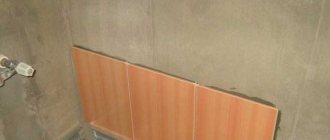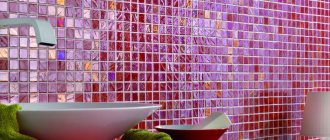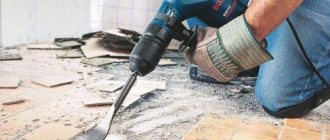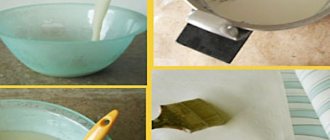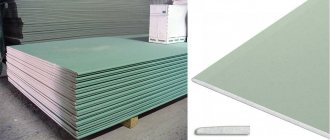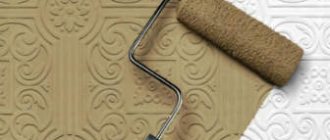SHARE ON SOCIAL NETWORKS
FacebookTwitterOkGoogle+PinterestVk
In the process of carrying out repair work with your own hands, you have to deal with many difficult questions, the correct answers to which will determine the quality and service life of the new finish. One such question is, can you lay tile on tile? Let's consider whether it is possible to use the old tile as a basis for a new coating or whether it is better to dismantle it to avoid possible problems.
Laying a new tile covering on tiles is possible subject to high-quality inspection and preparation of the base
Why you may need to preserve the old tile covering
There are several good reasons that give reason to think about refusing to dismantle the old coating before laying a new one. These are mainly economic factors, including:
- significant savings in time and effort spent on repair work;
It is worth considering that the new layer of tiles should not be too heavy if there is no confidence in the reliability of the base.
- Most likely, during the dismantling process you will have to deal with the breaking off of individual pieces of the cement-sand screed. This will entail additional work to replace or partially restore it. Also, if a prefabricated plasterboard and plywood leveling system was used, it will need to be replaced;
- During operation, dust will be minimal, which cannot be said about cases when old tiles have to be removed. In this case, it will be necessary to completely vacate not only the room itself, but also those adjacent to it, since often covering pieces of furniture and equipment with polyethylene is not enough;
- by preserving the old coating, you can avoid the need to remove construction waste;
- It happens that it is impossible to wait the period of time necessary for the new screed to completely harden. In this case, it is also better to use old tiles as a base.
Thus, there are many reasons to preserve the old coating. The main thing is to correctly assess whether it is possible to lay tile on tile in this case so that the resulting coating is sufficiently durable and reliable.
The use of high-quality adhesive determines the service life of the new tile layer
Is it possible to lay tiles on tiles: assessment of the old coating
In order to determine whether it is possible to lay a new tile on a layer of a similar coating, it is necessary to carry out a preliminary inspection of the existing base. First of all, you need to make sure that all elements are firmly fixed. You need to pay attention to the presence of any, even the smallest chips, cracks and loose elements. To do this, each tile needs to be tapped with a rubber hammer. Poorly secured elements will rattle.
All elements that are not fastened well enough or have cracks are sure to chip off. The decision to install new tiles over old tiles should be made based on how large a percentage of the old tiles are in good condition and are holding securely.
Helpful advice! Pay attention to the existing floor level. As a result of installing an additional layer, its height should not exceed the height of the threshold. If the thickness of the floor covering is too high, then before laying it will be better to dismantle the old covering and lay the new tile directly on the base.
Before laying a new layer of tiles, the base must be cleaned of dirt and marked
Brief characteristics of the material
Ceramic floor tiles are a durable material that demonstrates high performance characteristics. This coating is resistant to high levels of humidity, so it is actively used in bathrooms. It demonstrates high aesthetics, has a wide variation of patterns, colors and textures, therefore it is applicable in interiors of different stylistic orientations. Ceramics are practical and easy to use, easy to clean and dry quickly.
Let us note that the positive qualities of such a material for floor finishing appear to a greater extent if its installation is carried out in accordance with all the technology requirements. If the work is done thoughtlessly and in violation of the manufacturer’s recommendations, then such a floor will not last long.
Is it possible to lay tiles on tiles on the wall: features of the work
The main difficulty that one has to face in the process of installing a new coating on top of the old one is the influence of gravity, because over time the tiles will shrink, and the old base must withstand this. Therefore, it is necessary to ensure the highest quality adhesion between the layers. First you need to take care of cleaning the seams, at least partially removing the glazed layer of the tiles and purchasing concrete contact.
Helpful advice! Concrete contact is usually applied using a spatula or trowel, carefully leveling it so that the applied layer is as uniform as possible. Consumption should be approximately 300 grams per 1 m².
If laying a new floor covering is not planned, in the process of laying tiles on the wall, the floor must be protected. Skirting boards and flooring should be covered with plastic film to avoid the appearance of specific, and practically impossible to remove stains.
To improve the fastening of the new layer of tiles, concrete contact is applied to the old base
When working with a wall surface, the drying period of the concrete contact should be at least 5-7 hours. In this case, it is better to give preference to the densest synthetic modification possible.
Otherwise, the tiles are laid in the standard way gradually on small sections of the wall. This is due to the high drying speed of the adhesive composition. The elements are laid out over an area of 1-1.5 m² and pressed with some force. Before the glue completely hardens, some unevenness and imperfections can be corrected using a rubber mallet.
Thus, answering the question whether it is possible to lay tiles on tiles on a wall, the main attention is paid to the technology and intricacies of this process. If you follow the recommendations of specialists, the result of the work done will be more than satisfactory.
Tile elements are attached to the wall using special glue
Selection of adhesive composition
It is more difficult to lay cladding on other tiles than on monolithic concrete, so the adhesive composition used must have increased adhesion. In construction stores you can find special adhesives designed for installing new ceramics on old ones.
It is important to pay attention to the information on the packaging about what types of tiles and operating conditions a particular product is suitable for. Dilution and use are carried out at positive temperatures (but not higher than 25 degrees). The proportions of the liquid component and powder, as well as the process of preparing the glue, are indicated step by step on the packaging. In this case, the mixture is poured into a container with water (in no case vice versa). The components should be at room temperature.
How to lay tiles on tiles: surface preparation features
Having made sure that the old coating will withstand the expected load and is in good condition, you can proceed directly to preparing the surface for laying new tiles. First of all, you should make sure that the surface can provide the necessary level of adhesion, giving the old tiles roughness. You can achieve the desired effect in several ways:
- removing the top glossy layer from the tile;
- using a special primer for surface treatment;
- making notches on the tile.
Each of these methods has its own advantages and disadvantages. So, the simplest is to use a primer, but it requires financial investment. The other two do not require costs, but involve significant physical effort and a lot of dusty work.
Damaged elements of the old coating must be removed or notches made to improve adhesion
You can remove the top layer of tiles, as well as make the necessary notches, only with the help of a grinder. These procedures allow you to create the necessary contact between the bottom layer of the new tile and the old coating. It is not necessary to remove absolutely the entire top layer. 60% of the tile surface will be quite enough. As for the notches, they are placed at a distance of 1-2 cm from each other.
An easier and cleaner way is to use a tile primer. The composition, which is also called concrete contact, is capable of imparting the necessary properties to any smooth and waterproof surface. This composition adheres perfectly to the glazed surface of the tile, creating a rough layer on top, which serves as the basis for the tile adhesive.
Before laying a new layer of tiles, it is necessary to replace the grout of the old base.
Useful tips
Experts advise listening to the following rules when carrying out work:
- Be sure to carefully check each tile, regardless of its size, for voids and cracks;
- Be sure to carefully prepare the surface in terms of increasing its roughness;
- Be sure to remove dust and resulting crumbs at each stage. This is necessary in order to achieve the desired grip and nothing interferes with this;
- Use primers that help increase adhesion between the 2 layers of tile.
Be sure to remove dust and resulting crumbs at each stage.
It is imperative to lay out a new layer in such a way that the seams do not match, otherwise failures may form. It is not allowed to combine the dimensions of the tiles by placing one exactly on top of the other.
How to glue tiles onto tiles: step-by-step instructions
The technology for laying tiles on old tiles involves the following sequence of actions:
- Using cement-sand mortar, cover all areas of chips, cracks and irregularities in such a way as to level the surface as much as possible. After this, you need to wait for the solution to dry completely and clean the old coating, removing all dirt, lime deposits and moisture from it.
- Using one of the possible methods of ensuring adhesion, the old coating is treated. As already mentioned, the easiest way is to use a special primer for this purpose.
- Using a smooth spatula, tile adhesive is applied to the back side of the tile, after which the composition is leveled over the entire surface and special grooves are created on it using a notched trowel. Simply put, at this stage, tiles are laid according to standard technology.
Helpful advice! If we are talking about partial removal of glaze or notches, then personal protective equipment against small chipping particles and dust must be used during the work.
The process of laying a new layer of tiles on the old coating
It is important to know that in this case it will take more time for the adhesive to dry completely. This is due to the low absorption capacity of the base. That is why it is best to carry out all work related to grouting no earlier than 3-4 days after installation. At the same time, the standard technology, which involves the use of a special composition and a rubber spatula, is completely preserved.
Preparing the base for a double tile field
Whatever the glue, the surface for it is prepared very carefully.
First, check how tightly the old tiles hold. Unreliable places are patched up. The lagging elements are cleaned and fastened back. If the tile field is unreliable, installing a new one on top is impractical.
At this stage, it is very important to decide which of the 2 methods to use to prepare the old tiles. This:
- Cleaning the glaze;
- Applying small notches to the glaze of the material;
- Treatment of tiles with a specialized primer “Betonokontakt”.
Method 3 is the simplest - you won’t have to fiddle around for a long time, there won’t be a lot of dust, and there’s no risk of damaging the base. This solution will create a rough surface favorable for installation.
At the last stage, the surface should be thoroughly cleaned of dust and dirt, degreased and primed, unless Concrete Contact was selected (in this case, all this work is carried out before its application).
How to understand that you should not glue tiles on tiles: recommendations from experts
Before gluing tiles, every owner wants to be sure that his work will not be in vain, and the new coating will serve well for many years. That is why it is worthwhile to first familiarize yourself with the recommendations given by experts. They indicate aspects that may prevent the elements from being securely fastened and serve as a warning sign that you should pay attention to:
- During the tapping process, the tile retains its integrity, but the sound that is heard is not uniform. This may indicate the presence of air voids under the tile, which in the future can lead to its destruction. The thing is that the old solution may not withstand the load and eventually both layers of coating will fall off;
Before laying a new layer of tiles, it is worth checking the fastening of all individual elements of the base by tapping them with a rubber hammer
- Most often the question arises whether it is possible to lay tiles on tiles in a bathroom or toilet. In this case, you also need to pay attention to the size of the room, because these rooms are quite rarely spacious, which means an additional layer of mortar and facing material will reduce the already small area of the room. So if you see in advance that this method will affect the size of the room, it is better to remove the old tile and lay a new one in accordance with all the rules;
- A bad base is old, cracked tiles, the top layer of which has natural damage and is prone to chipping. If you lay another layer of tile on such a base, then most likely it will not last long, and in the near future all the work will have to be redone. And this will entail not only a significant investment of time and effort, but also financial costs;
- Before laying tiles on top of a layer of old facing material, you need to make sure that this will not interfere with free access to all communications and inspection hatches. Otherwise, the slightest damage will lead to the need to dismantle both layers of tiles at once to carry out repair work. In this case, it is wiser to think through everything in advance so that you do not have to face such serious problems in the future;
When laying over old tiles, the floor tiles have special performance requirements.
- Do not lay tiles on uneven floors. No matter how hard you try, the situation with the slope will only get worse due to the additional layer, so it is better to first dismantle not only the tiles, but also the old screed. By carrying out the repairs properly, you can eliminate the existing distortion as much as possible. This is also worth paying attention to before laying tiles on an uneven wall.
Having considered all these recommendations, we can conclude that before you start laying tiles over old tiles, you need to carefully weigh all the arguments. There is always a risk that the old coating will not withstand the load and simply fall off, destroying the new layer at the same time, and it is better to think through all possible options in advance so that, if necessary, abandon this idea.
Related article:
How to lay tiles on the floor: installation methods and technology features
Features of preparation of various types of surfaces. How to rub seams. Criteria for choosing tile coverings and laying patterns for the floor.
Advantages and disadvantages
Using old tiles as a base for new tiles has both advantages and disadvantages.
The advantages include the following factors:
- Saving time and labor costs.
- There is no need to apply a new screed, the drying of which can take up to a week, depending on the layer.
- Saving money. In order to level the walls after dismantling, you will need to purchase screed materials, which is an additional expense.
- If the old tiles were laid on plasterboard sheets or plywood used for leveling, they will have to be replaced.
- There is no need to dismantle sanitary equipment, which simplifies the process and reduces the risk of damage to devices.
Flaws:
- If there are voids under the old cladding that are not detected in a timely manner, the new one may crack over time.
- If previously low-quality glue or plaster with sand was used during installation (as was done in Soviet times), then under the additional loads created by the new cladding, they may begin to crumble. The result of this will be the appearance of defects on the new tile.
- One of the disadvantages of the technology is considered to be raising the floor level. As a result, in the bathroom it will be higher than in the hallway, which in the event of an accident (faucet breakdown) can lead to the risk of flooding the entire apartment.
How to remove old grout from tile joints
Quite often you have to deal with a situation where the condition of the old tile is quite satisfactory, but in order to use it as the basis for a new coating, it is necessary to replace the grout for the joints. It is quite possible to carry out this procedure, however, it requires attention and time. Let's look at how to remove grout from tile joints correctly.
Use a grout remover to remove old grout.
In order to remove old grout, there is a special tool called a “grout remover.” It can be used to remove grout mechanically. By itself, it is a blade with a comfortable handle, but as an alternative, you can use a regular knife.
The blade of a knife or embroiderer must be passed on both sides at an angle and straight. When doing this, you need to be careful not to chip the edges of the tiles. It is worth noting that this cannot be done quickly “by hand”, so you can use a drill with a thin drill bit or an electric chisel.
Important! If, in the process of removing the old grout, the tiles also begin to crumble, it is better to abandon the idea of laying another layer on top, even if there is new grout.
How to remove old grout from tile joints if it is silicone
Silicone grout also requires dismantling and replacement, especially if the room has not been provided with high-quality ventilation. Very often you have to deal with the fact that the seams are affected by mold, which is almost impossible to remove. Therefore, before laying new tiles over old tiles, you need to take care of the hygiene of the joints.
You can remove old silicone grout using a special tool or a regular knife.
Removal of silicone sealant is carried out using a sharp knife or a special scraper. After this, additional cleaning is carried out using a vacuum cleaner.
Helpful advice! There are special products that allow you to remove silicone faster and with less effort. Such compositions are applied using a mounting gun, after which it is necessary to wait at least 24 hours. Then the seams are wiped with a rag or paper.
Is it possible to lay tiles on tiles on the floor: features of the work
Floor coverings, unlike wall coverings, are not subject to gravity. Therefore, in a sense, installation is easier. But in this case, another difficulty arises - the new coating will regularly be subject to serious loads.
Before gluing tiles to the floor, you need to carry out an equally thorough check of each element of the lower layer. To do this, you can use the same hammer for tapping, but you can try another approach: an object with a flat base (a box works well), you need to smoothly drag it across the surface, carefully observing that not a single tile falls even a few millimeters. It can be difficult to do this in a small bathroom or toilet, but for larger rooms this is a very effective way.
When laying a new layer of tiles, you should pay special attention to the floor level
In general, all the recommendations provided in the previous section are also relevant when working with floors. It is only advisable to give preference to mineral compositions. Thus, the surface will be provided with greater elasticity, which will allow it to withstand heavy loads and temperature changes.
Helpful advice! Before laying floor tiles over an old ceramic coating, you don't have to do as much prep work as you would with a wall surface. But it’s still worth moistening the base before you start applying glue, as this will have a positive effect on adhesion.
Choosing adhesive for new tiles
When purchasing, you don’t need to take the first glue you see or the cheapest one. Since using a base for new tiles from old tiles is not in itself a good thing, preference should be given to compositions from well-established manufacturers.
The first thing you need to pay attention to is what surfaces it is suitable for. This information is available on the packaging. Experts advise choosing Ceresit SM17 glue. It is designed to work with complex surfaces, which include a previously used tiled base.
Another option is Ivsil Profit tile adhesive. This is a composition for laying porcelain tiles, but in the case of a base made of old tiles, it is best suited because it has high adhesion and increased physical strength.
Calculation of the required amount of composition
The calculation is carried out based on the consumption of the composition per 1 m² of surface to be coated. Each type of tile adhesive has its own consumption for such an area. The necessary information can also be found on the packaging with the composition. Therefore, before going to the store, you need to calculate the floor area that needs to be finished.
In addition, there are special calculators on the Internet for calculations. They are convenient because they take into account not only the area to be finished, but also the brand of adhesive. All that remains is to enter the desired number, click on the selected composition and get the desired result. There is another type of calculators that take into account indicators such as area, type of surface to be treated and dimensions of ceramic tiles.
But since the bathroom area is small, you don’t have to resort to complex actions. The information on the packaging with the composition is enough.
Is it possible to make a self-leveling floor on old tiles?
As a basis for a new coating, you can also use a self-leveling floor, which is installed directly on the surface of the old tile. As in all previous cases, a mandatory procedure is a thorough check of the quality of fastening of the lower layer. All loosely fitting elements must be dismantled.
The self-leveling floor can be used as a base for laying a new layer of tiles
It is also worth paying attention to the fact that in cases where we are talking about working with a glossy surface, the top layer of coating is removed to ensure the necessary level of adhesion between the solution and the tile. Filling and further work are carried out according to the standard algorithm.
Helpful advice! Laying a new layer of tile does not require a thick layer of self-leveling floor. Its thickness should not exceed 5 mm. The main thing is to distribute the composition evenly over the entire surface.
Taking into account the opinion of experts, we can say that installing a self-leveling floor on top of tiles is possible only in extreme cases. In this case, the area of the room should be small, and the requirements for the operational characteristics of the surface should be minimal.
What to glue: brands of tile adhesive
To ensure high-quality gluing of tiles to tiles, you need to buy high-quality tile adhesive that meets the requirements. There are adhesives on sale for gluing tiles to difficult surfaces:
- Kreisel 104 - designed for gluing all types of tiles, even large ones, to solid bases, planes that are subject to deformation and have poor adhesion properties. The glue has increased elasticity. Contains Portland cement, mineral fillers, modifiers.
- Ivsil profit - for laying tiles on complex substrates. Suitable for all premises with different operating conditions. Provides excellent adhesion and seam strength. It is frost and water resistant. It is produced on the basis of cement with polymer additives and plasticizers.
- Ceresit CM 17 is an adhesive with super-elastic properties, specializing in laying all types of tiles on any surface, including those subject to deformation. Provides increased adhesion.
- Timmax Titan K 50 is an adhesive with strong fixation. It has frost- and moisture-resistant properties and is used when working with a “warm floor” system. Quick setting, time to adjust elements 15 minutes. It is used for laying all types of tile elements in various conditions. Cladding over old elements is also allowed.
- Plitonit S is a special product for gluing all types of tile raw materials onto various surfaces: painted, alkaline adhesive residues, particle boards, the previous base that has not been removed, etc. It has increased flexibility, frost and water resistance, and is easy to use. Operation of the working plane is allowed at temperatures of -50 – +80 degrees, the seam should not exceed a thickness of 2 cm, and is available in bags of 5.25 kg. Correction time is half an hour. Complete drying in a day, time for grouting work too. Seam guarantee 15 years.
